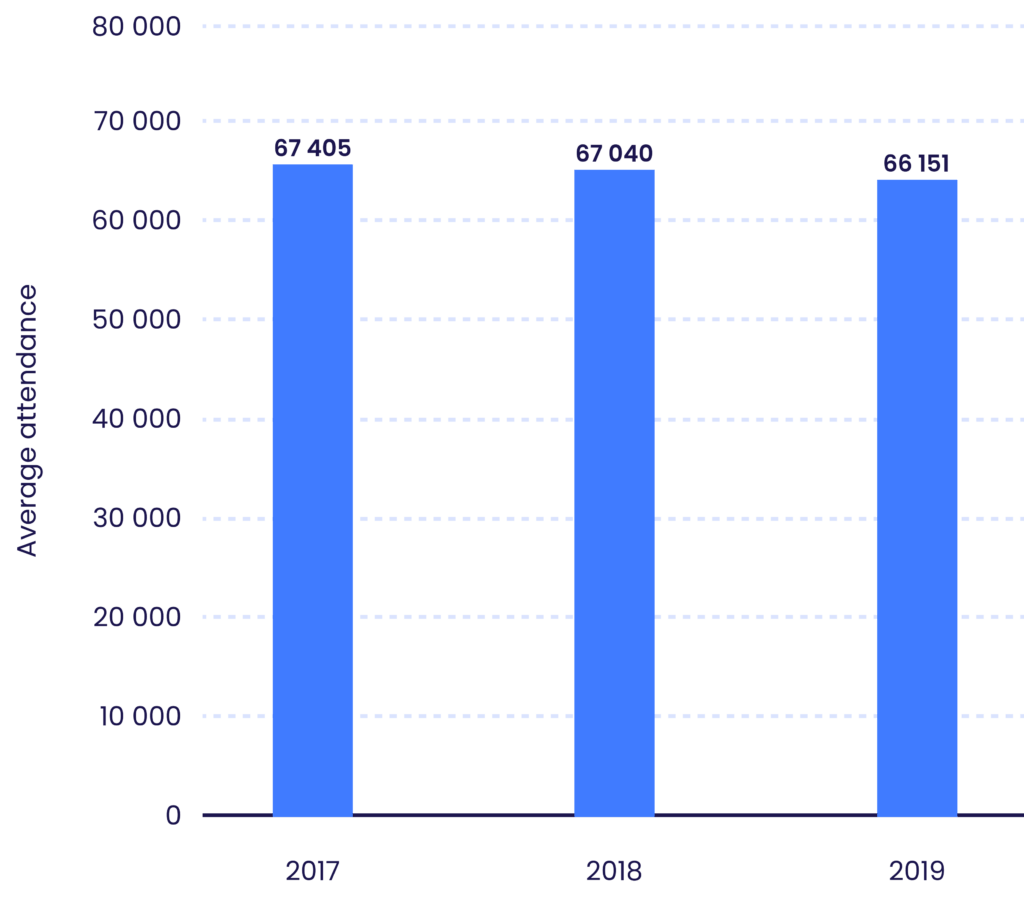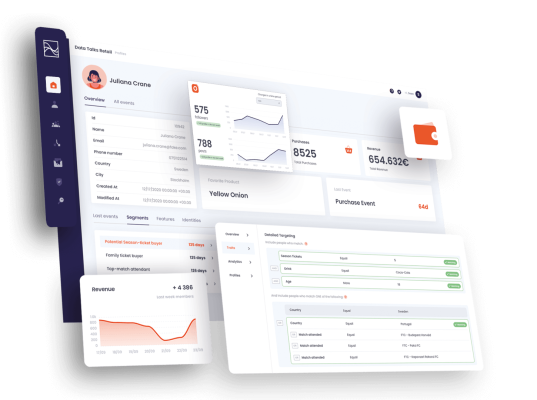
Did you know that data is one of the most valuable assets an organization could ever have? Unfortunately, this is something that the sports industry is only just starting to catch on to. Of course all data is important but, in this post, we are going to discuss data sports organizations shouldn’t ignore… this time around.
Before we dive right in...
Subscribe to our blog today to ensure that you never miss valuable posts such as this one. We are passionate about helping sports organizations deliver a world-class fan experience, because better fan experience means better business. So why not use this opportunity to the fullest?

Why “this time around”?
As we have already mentioned, the sports industry is only beginning to catch on to the importance of data. So naturally, this means that a lot of data has been wittingly or unwittingly ignored by sports organizations. Supporter data, for example, is one type of data that has been underutilized. So with this post, we are essentially saying to you, hey, it’s time to stop making the mistake of ignoring data.
Why this discussion matters
We are sports customer data platform experts (CDP) so we know the difference between having data or not having data can make on any organization’s health and performance. This is not the first time we are delving into this subject, that’s how important we think it is. We believe that all sports organizations need a sports CDP.
Data, is essentially the foundation and building block of any successful marketing strategy. That’s why you should start prioritizing data collection and analysis.
Data sports organizations shouldn’t ignore
The picture that we are about to paint for you, however, has both positive and negative elements. That’s because we would rather give you a full and true picture and then equip you with the right information so that you can find your way to success. Success being, an understanding of why data matters to you.
So let’s dive right into data sports organizations shouldn’t ignore.
The context
It’s 2022 and we still haven’t quite found our way back to “normal” yet. Now more than ever, sports organizations have to think ahead and almost future proof their marketing efforts. In addition, you have to somehow find a way to keep your supporters engaged while also maximizing income.
Even though we are not living in the post-covid future we were hoping to be living in by now, more and more sports fans are actually willing to attend live sports games than ever. In fact, if you compare attendance statistics of 2019 to 2021, you will be shocked to learn that, in some games, the numbers have never been better.
So this natually becomes our first point of departure on, data sports organizations shouldn’t ignore.

PRE-COVID ATTENDANCE STATISTICS
The first data sports organizations shouldn’t ignore is pre-covid attendance statistics
- Did you know that in the three years preceding the COVID pandemic (from 2017 to 2019), the NFL (National Football League) live game attendance was declining? And, however, during the 2021 season, NFL average total regular season home attendance per team was the highest it ever has been in the last 15 years?
- Even in football, the UK for example has been recording football attendance numbers exceeding pre-pandemic statistics.
- And did you also know that in 2017, 59% of American sports fans said they preferred to watch games from home? This is well before the pandemic.
- In the US, only three sports are seeing success amongst Gen Z. These are basketball, boxing/MMA, and soccer. This is not a consequence of COVID but was already the case even before.
National Football League average per game attendance

Source: Statista 2022
Why is this data sports organizations shouldn’t ignore?
Why do we say that pre-covid attendance statistics are data sports organizations shouldn’t ignore?
Well, have you ever heard of the phrase, “going back to normal”? Of course you have because that is something that we have been all pinning for. But if normal within the sports industry context means declining matchday attendance, then is this something that we should want to go back to?
The data shows that the pandemic was not the cause of the decline in sports attendance but actually only highlighted and accelerated trends and problems that already existed. That is, although supporters now have to watch some games from home and not in-stadium because of COVID, the majority already preferred doing so, even before COVID. Another fact is, even though some sports are experiencing a decline in viewership, this was already the case even before the pandemic.
Here’s what we can deduce from this data:

Increased appetite for sports
In some sports, the inability to attend any live games in 2020 has awakened a great appetite for more. So many fans are waiting to jump at the opportunity to be able to attend games again. In a way, there is more excitement for live games now more than ever before.
A great example in history
If you read about football history actually, you find out that the only other time that the Football Association (FA) in the UK ever abandoned matches was in 1939, when the government had declared war on Nazi Germany. And that during that time of war, football brought healing and unity in a time of crisis. English football began to boom after the second world war.
“During the war, the Dutch read more books and attended more plays, films, concerts, and probably church services than before, but no other form of entertainment grew as quickly as sport. What else was there to do? Today’s bereft fans will know the feeling. People have a craving for weekly football. Some may even need it.”
Source: ESPN
The parallels between the wars and the pandemic show that there is something about hardship and adversity that makes fans hunger for sports.
What do you need to do?
You, therefore, need to leverage this momentum and give your supporters something to pull them away from the harsh reality of life as it is. And how do you do this? By delivering a world-class supporter experience. This is why sports attendance statistics, especially the increase in appetite for sports, is the kind of data sports organizations shouldn’t ignore.

Some Sports Fans Are/Were Losing Interest In Sports
The pre-covid data shows that many sports were losing fans. This is another fact we can deduce from pre-covid attendance statistics. The pandemic has only shone a light on a problem that already existed. So COVID is not necessarily the cause of this loss of interest.
Here are some interesting facts:
- Only 38% of kids aged 6 to 12 played an organized sport in 2018. This was down from 45% in 2008
- In 2018, Major League Baseball (MLB) was down to the lowest ever attendance in over 15 years
- Only 25% of Gen Zers watch sports once a week and nearly 40% never watch sports
The lack of interest in sports is almost everywhere. From kids to major leagues and to new generations; sports fan engagement has been changing. However, this is not all bad news at all.
Did you know that 57% of sports fans say that sports define them? When you compare this to only 30% of people who say that religion defines them, this is a huge deal. People care deeply about sports so there is a lot that you and your sports organization can do to keep your fans and supporters engaged.
What do you need to do?
So although this seems rather paradoxical, it is definitely data that sports organizations shouldn’t ignore. Especially because it shows you areas to focus on (increasing sports attendance) and how to focus on them (by connecting with supporters’ love for sports). So in a nutshell, you need to act fast and win back fans. Furthermore, this means leveraging the current appetite for sports many sports fans currently have.

Fans’ Sports Consumption Preferences Have Changed
As times have changed due to digitalization, a lot of fans’ preferences have changed too. This very reason is another compelling reason, pre-COVID attendance statistics is data sports organizations shouldn’t ignore.
- As previously mentioned, more than half of all sports fans in America preferred watching sports from home, even before the pandemic.
- Only 41% of Gen Zers use traditional television to watch sports
- OTT streaming services have been growing at an exponential rate, with Gen Zers for example, preferring that to traditional television.
- Sports fans of the future and their preferences look different from the generations past.
If sports organizations do not find a way to appeal to the younger generation, they could be on a fast track to shrinking, if not going extinct altogether. Dire we know and almost entirely improbable right? Well the MLB statistics might prove otherwise.
What do you need to do?
You need to get to know your fans and really understand them. And then you need to be able to reach them with the right message and experience, at the right time and in the right channel. This needs to happen at the individual level and not just an overarching approach. Additionally, some innovation and outside-the-box thinking are therefore required. More on this later.
Why this is crucial data sports organizations shouldn’t ignore
In addition to all the above, there are other challenges that you and other sports organizations are facing. We are pretty sure that you are struggling or have struggled with at least one of these problems.
- Dwindling revenue streams because of canceled in-stadium games
- Sponsorships and partnerships that are being threatened by the unpredictability of the times we are living in
- Trying to maximize marketing spend in a time where positive outcomes are not guaranteed
- The future of your organization if traditional ways of “doing sports” (in-stadium) can’t be relied on anymore
- Trying to come up with a sustainable solution to your current problems
- Foolproofing the future of your organization as much as possible so that you can survive whatever unpredictable situations you might encounter in the future
We don’t want you to add another problem to your already existing challenges. Being data-driven and knowing crucial data to not ignore is a bit part of solving not just this problem, but all the above-mentioned as well. That’s why we are writing on data sports organizations shouldn’t ignore. Because it is easy to miss important details sometimes, and that’s where we come in. Data is an area we are passionate about so we are always on the lookout for patterns that maybe your sports organization is not necessarily aware of.
But why are we discussing COVID now?
Covid restrictions look different depending on where you live. For some countries, there are no restrictions while for others restrictions are still in place. Whatever the case, we know that COVID is still relevant. What with the latest controversy regarding Novak Djokovic and the Australian Open. The situation was far from “normal”, that is, it is not something anyone could have anticipated in 2019, pre-COVID.
So you see, although the prognosis on COVID now is better than two years ago, we are still dealing with the aftermath.
But what can give you the ultimate edge in your attempt to address all the above?
The current challenges you are facing in your organization are multi-faceted which makes them slightly challenging to solve. So you need a solution that can help solve as many of your problems as possible. Because otherwise, finding individual solutions for each problem would be a very expensive endeavor. But don’t worry, we have the perfect solution. Everything we have discussed so far shows why sports organizations need a CDP in that, it can all be addressed using a CDP. Remember we said:

You need to act fast and win back fans

You need to get to know your fans and really understand them

And that you need to leverage this momentum and give your supporters something to pull them away from the harsh reality of life as it is
Well, the best way to do any of this is to use a sports CDP.
Conclusion
Sports organizations such as yours have an advantage at the moment. There is a hunger for more sports because of the restrictions fans have had to contend with. The only way sports organizations can leverage this current momentum – is to work in a data-driven way. The importance of data-driven sports marketing has already been established. So we won’t go into details here at all.
But in a nutshell, you need to:

Effectively collect and store supporter data

Analyze it

And use it to gain insights to drive your decision making
And a sports CDP is exactly the solution that will help you achieve all this and more.

Leave a Reply